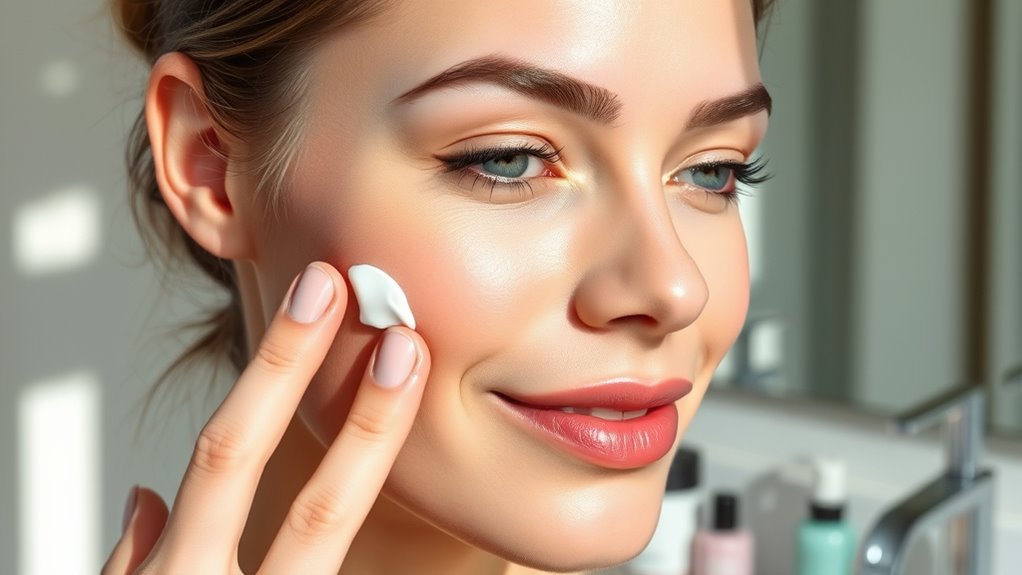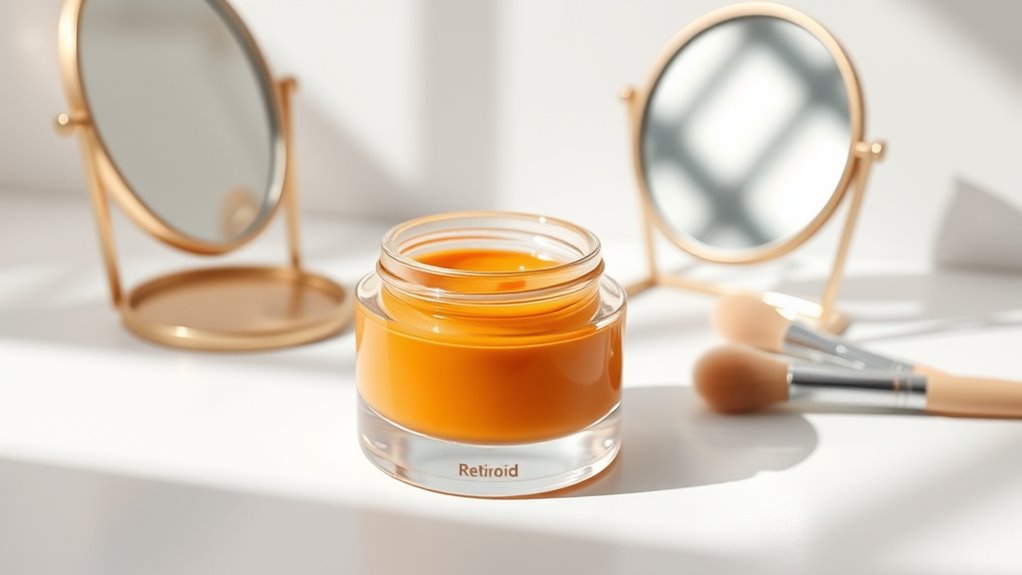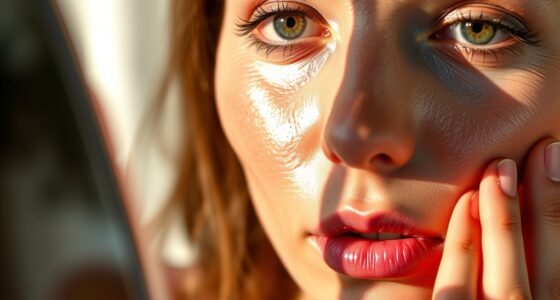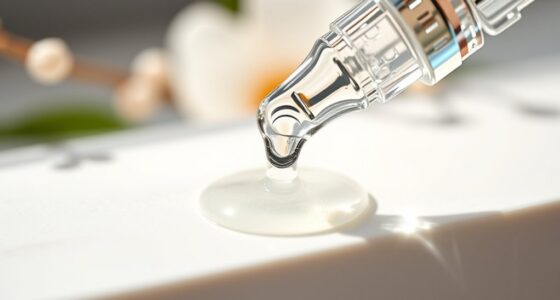As a beginner, you can expect some initial redness, dryness, or peeling as your skin adjusts to retinoids—these reactions are normal and usually temporary. Start slowly by applying a small amount once or twice a week and gradually increase frequency. Consistent use and patience are key to seeing smoother, clearer skin over time. To avoid irritation, focus on proper application, use sunscreen daily, and listen to your skin’s signals for better results. Keep going to learn more!
Key Takeaways
- Expect initial redness, dryness, or peeling as your skin adjusts; these are normal and temporary.
- Start with a small amount once or twice a week, gradually increasing as your skin tolerates.
- Consistent use over several weeks is needed to see significant improvements in skin texture and clarity.
- Always apply retinoids on clean, dry skin and use broad-spectrum sunscreen daily to protect against sun damage.
- Monitor your skin’s response and adjust frequency or concentration to minimize irritation and maximize benefits.

If you’re new to skincare, retinoids might seem intimidating at first, but they’re powerful tools for improving your skin’s appearance. Starting with retinoids means understanding how they work and what to expect. One of the most important things to consider is skin sensitivity. When you first begin using retinoids, your skin might react with redness, dryness, or peeling. These reactions are normal and usually temporary, but they can be uncomfortable if you’re not prepared. To minimize irritation, it’s best to start slowly—applying a pea-sized amount once or twice a week and gradually increasing frequency as your skin builds tolerance. Remember, patience is key. It can take several weeks for retinoids to show significant results, so don’t get discouraged if you don’t see immediate changes.
Application tips are crucial for getting the most benefit from retinoids while reducing the risk of irritation. Always apply retinoids on clean, dry skin. Wait a few minutes after washing your face to ensure your skin is fully dry, as applying retinoids on damp skin can increase sensitivity. Use a small amount, spreading it evenly over your face, avoiding the delicate skin around your eyes. If you’re using other skincare products, such as exfoliants or acids, it’s best to use them on different nights or consult your dermatologist to avoid potential interactions that could heighten skin sensitivity. Also, because retinoids can make your skin more prone to sun damage, applying a broad-spectrum sunscreen daily is essential. During the initial phase, if your skin becomes too irritated, you might want to reduce application frequency or switch to a lower concentration retinoid. Additionally, understanding skin sensitivity can help you tailor your routine for better results.
As you become accustomed to retinoid use, you’ll learn how your skin responds and adjust your routine accordingly. Incorporate a gentle moisturizer to help combat dryness and peeling, which are common side effects. It’s also advisable to avoid harsh scrubs or strong exfoliants during this time, as they can worsen irritation. Keep in mind that consistency is key—using retinoids regularly, with proper application tips, will eventually lead to smoother, clearer skin. Be mindful of your skin’s signals, and if irritation persists or worsens, consult a dermatologist. They can recommend alternative formulations or concentrations better suited for sensitive skin. With patience and proper application, retinoids can become a valuable part of your skincare routine, helping you achieve healthier, more radiant skin in the long run.
Frequently Asked Questions
Can Retinoids Be Used on Sensitive Skin?
If you have sensitive skin, you can still use retinoids, but with caution. For example, someone with skin sensitivity noticed redness and irritation at first, so they started with a lower concentration and applied it every other night. Retinoids can be compatible with sensitive skin if you gradually introduce them and choose gentle formulations. Always patch-test first and consult a dermatologist to guarantee ingredient compatibility for your skin type.
How Long Does It Take to See Results?
You can typically expect to see visible improvements within 4 to 12 weeks of consistent retinoid use. Keep in mind that timeline expectations vary depending on your skin type and concerns. Patience is key, as retinoids gradually promote cell turnover, leading to clearer, smoother skin. Stick with your routine, and you’ll notice changes over time, especially when you maintain regular application and follow proper skincare practices.
Are There Any Natural Alternatives to Retinoids?
Yes, there are natural remedies and plant-based alternatives to retinoids. You can try products with ingredients like rosehip seed oil, rose water, or aloe vera, which promote skin renewal and hydration. These options are gentler and suitable for sensitive skin. While they may take longer to show results, they support your skincare routine naturally. Always patch-test new remedies and consult with a dermatologist for personalized advice.
Can Retinoids Be Combined With Other Skincare Ingredients?
Think of skincare as a symphony—you can layer ingredients to create harmony. You can combine retinoids with other ingredients, but be cautious. Avoid mixing retinoids with strong acids during application and always layer products carefully. It’s best to apply retinoids at night and separate them from acids or exfoliants. This way, you prevent irritation and maximize benefits, giving your skin a gentle yet effective treatment.
What Should I Do if I Experience Severe Irritation?
If you experience severe irritation, stop using the retinoid immediately, as it may compromise your skin barrier. Focus on soothing remedies like applying a gentle, fragrance-free moisturizer and avoiding harsh cleansers. Keep your skin hydrated and limit sun exposure. If irritation persists, consult a dermatologist to ensure you’re using the right product and to get personalized advice on healing your skin barrier effectively.
Conclusion
Starting your retinoid journey is like planting a tiny seed—patience and consistency will help it blossom into radiant skin. Expect some initial challenges, but remember, every sunset leads to a sunrise. Stick with it, nurture your skin, and soon you’ll see the glow you’ve been dreaming of. Your skin’s transformation is a beautiful painting in progress—trust the process, and watch your confidence shine brighter than ever before.









